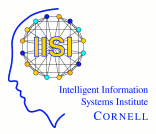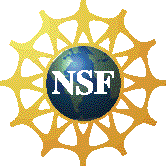Tutorials
We will be offering three tutorials
Partially observable Markov decision processes, or POMDPs, are a
very general model for sequential planning and decision making
under uncertainty. They allow one to model uncertainty in the
effects of actions, restricted ability to sense the state of the
world, and very general reward (or objective) functions. In this
tutorial, I describe the basic ingredients of (discrete) POMDPs,
the conversion of POMDPs to fully observable ``belief state'' MDPs,
and describe several standard solution techniques developed largely
in the operations research community (but also variants developed
within the AI community). I also briefly overview the application
of AI representation and approximation techniques for the solution of
large scale POMDPs.
Craig Boutilier is the chair of the Department of Computer Science at
University of Toronto and a member of Artificial Intelligence Group. His
current research efforts focus on various aspects of decision making under
uncertainty: decision-theoretic planning and Markov decision processes; game
theory and multiagent decision processes; economic models; reinforcement
learning; probabilistic inference; and preference elicitation. In a past
research life, he spent quite a bit of time working in the areas of knowledge
representation, belief revision, default reasoning, and philosophical logic.
How can we mine the Internet graph over time? How do we model social
and biological networks to help us understand or predict the behavior
of these systems? What properties do they have? How do we find
communities in networks? How is machine learning with graphs done? What
kind of dynamical processes are talking place on the networks?
In this talk I will give an overview of the field that brings together
physicist, sociologists, and computer scientists. I will review the
state of the art in four related fields: (a) graph mining, (b) graph
theory, (c) machine learning with graphs, and (d) social networks. I
will present both theoretical results and algorithms as well as case
studies on several real applications. The emphasis is on the intuition
behind each method, and on guidelines how to use them.
Jure Leskovec is a PhD candidate in machine learning at Carnegie
Mellon University. He received ACM KDD 2005 best research paper award, won ACM
KDD cup competition in 2003, holds two patents, and is a Microsoft
Research Graduate Fellow. His research interests include machine
learning and data mining on large real-world graphs and networks.
Slides from the tutorial
The sparsity pattern of a vector, the number and location of its non-zeros,
is of importance in varied settings as structure learning in graphical models,
subset selection in regression, signal denoising and compressed sensing. In
particular, a key task in these settings is to estimate the sparsity pattern of
an unknown ``parameter'' vector from a set of n noisy observations.
The task can be understood simply as identifying signals from noise.
Suppose a set of ``signals'' (edges in graphical models, covariates in
regression) enter into linear combinations, and have observations which are
functions of these linear combinations with added noise. The task is to
identify the set of relevant signals from n such noisy observations. In
graphical models for instance, the task in structure learning is to identify
the set of edges from the noisy samples.
This is an intractable problem under general settings, but there has been a
flurry of recent work on using convex relaxations and L1 penalties to recover
the ideal sparse signal. In particular, fairly general conditions have been
proposed under which computationally tractable methods can recover the true
sparsity pattern of the signal.
The tutorial will cover the basic problem abstraction, the applications in
various settings and some general conditions under which the tractable methods
``work''. It will also focus in particular on the application setting of
structure learning in graphical models.
Pradeep Ravikumar is a PhD Candidate at Carnegie Mellon University,
advised by John Lafferty. He received his Bachelor of Technology in Computer
Science and Engineering from the Indian Institute of Technology, Bombay. His
research
interests include machine learning, statistical learning theory, optimization
and information integration.
|


